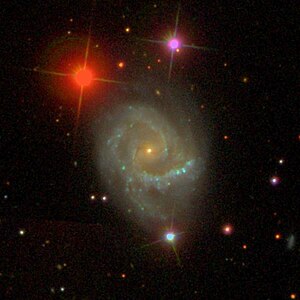NGC 7678
| Galaxy NGC 7678 |
|
|---|---|

|
|
| SDSS recording | |
| AladinLite | |
| Constellation | Pegasus |
|
Position equinox : J2000.0 , epoch : J2000.0 |
|
| Right ascension | 23 h 28 m 27.9 s |
| declination | + 22 ° 25 ′ 16 ″ |
| Appearance | |
| Morphological type | SAB (rs) c / Sbrst / Sy2 |
| Brightness (visual) | 11.8 mag |
| Brightness (B-band) | 12.5 mag |
| Angular expansion | 2.5 ′ × 1.7 ′ |
| Position angle | 5 ° |
| Surface brightness | 13.2 mag / arcmin² |
| Physical data | |
| Affiliation | LGG 474 |
| Redshift | 0.011639 ± 0.000017 |
| Radial velocity | 3489 ± 5 km / s |
|
Stroke distance v rad / H 0 |
(164 ± 11) · 10 6 ly (50.2 ± 3.5) Mpc |
| history | |
| discovery | Wilhelm Herschel |
| Discovery date | September 15, 1784 |
| Catalog names | |
| NGC 7678 • UGC 12614 • PGC 71534 • CGCG 476-045 • MCG + 04-55-017 • IRAS 23259 + 2208 • 2MASX J23282789 + 2225162 • Arp 28 • VV 359 • GC 4971 • H II 226 • h 2245 • LDCE 1578 NED004 | |
NGC 7678 = Arp 28 is an active barred spiral galaxy with extensive star formation from Hubble type SBc in the constellation Pegasus at the northern sky . It is an estimated 164 million light years from the Milky Way and about 115,000 light years in diameter .
Halton Arp organized his catalog of unusual galaxies into groups according to purely morphological criteria. This galaxy belongs to the class spiral galaxies with a pronounced arm (Arp catalog) .
The object was discovered on September 15, 1784 by the astronomer Wilhelm Herschel and later included in his New General Catalog by Johan Dreyer .
NGC 7678 group ( LGG 474 )
| Galaxy | Alternative name | Distance / million Lj |
|---|---|---|
| NGC 7678 | PGC 71534 | 164 |
| NGC 7673 | PGC 71493 | 160 |
| NGC 7677 | PGC 71517 | 167 |
| NGC 7664 | PGC 71450 | 163 |
literature
- Jeff Kanipe and Dennis Webb: The Arp Atlas of Peculiar Galaxies - A Chronicle and Observer's Guide , Richmond 2006, ISBN 978-0-943396-76-7
